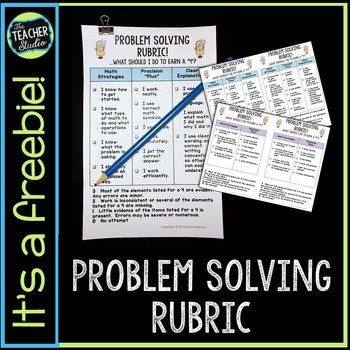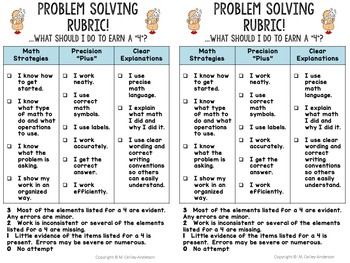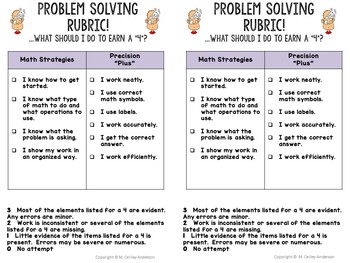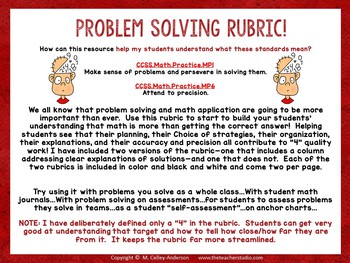The Teacher Studio
17.8k Followers
Grade Levels
2nd - 5th
Subjects
Resource Type
Standards
CCSSMP1
CCSSMP3
CCSSMP6
Formats Included
- PDF
Pages
3 pages
The Teacher Studio
17.8k Followers
Description
How can this resource help me assess the Standards for Mathematical Practice?
How can this resource help my students understand what these standards mean?
CCSS.Math.Practice.MP1
Make sense of problems and persevere in solving them.
CCSS.Math.Practice.MP6
Attend to precision.
We all know that problem solving and math application are going to be more important than ever. Use this rubric to start to build your students’ understanding that math is more than getting the correct answer! Helping students see that their planning, their Choice of strategies, their organization, their explanations, and their accuracy and precision all contribute to “4” quality work!
Try using it with problems you solve as a whole class…With student math journals…With problem solving on assessments…for students to assess problems they solve in teams…as a student “self-assessment”…on anchor charts…
NOTE: I have deliberately defined only a “4”. Students can get very good at understanding that target and how to tell how close/how far they are from it. It keeps the rubric far more streamlined.
--------------------------------------------------------------------------------
Want to see some other problem solving resources? Here is just a sampling of the many resources in my store!
Multi-Step Word Problems for Grades 3/4
Word Problem Bundled Set for Grades 4/5
Word Problem Bundled Set for Grades 3/4
Back to School Word Problems
Seasonal Word Problem bundle (individual sets also available)
"Amazing Facts" Task Card Bundle (individual sets also available)
CGI Word Problem Bundle (individual sets also available)
--------------------------------------------------------------------------------
All rights reserved by ©The Teacher Studio. Purchase of this resource entitles the purchaser the right to reproduce the pages in limited quantities for single classroom use only. Duplication for an entire school, an entire school system, or commercial purposes is strictly forbidden without written permission from the author at fourthgradestudio@gmail.com. Additional licenses are available at a reduced price.
How can this resource help my students understand what these standards mean?
CCSS.Math.Practice.MP1
Make sense of problems and persevere in solving them.
CCSS.Math.Practice.MP6
Attend to precision.
We all know that problem solving and math application are going to be more important than ever. Use this rubric to start to build your students’ understanding that math is more than getting the correct answer! Helping students see that their planning, their Choice of strategies, their organization, their explanations, and their accuracy and precision all contribute to “4” quality work!
Try using it with problems you solve as a whole class…With student math journals…With problem solving on assessments…for students to assess problems they solve in teams…as a student “self-assessment”…on anchor charts…
NOTE: I have deliberately defined only a “4”. Students can get very good at understanding that target and how to tell how close/how far they are from it. It keeps the rubric far more streamlined.
--------------------------------------------------------------------------------
Want to see some other problem solving resources? Here is just a sampling of the many resources in my store!
Multi-Step Word Problems for Grades 3/4
Word Problem Bundled Set for Grades 4/5
Word Problem Bundled Set for Grades 3/4
Back to School Word Problems
Seasonal Word Problem bundle (individual sets also available)
"Amazing Facts" Task Card Bundle (individual sets also available)
CGI Word Problem Bundle (individual sets also available)
--------------------------------------------------------------------------------
All rights reserved by ©The Teacher Studio. Purchase of this resource entitles the purchaser the right to reproduce the pages in limited quantities for single classroom use only. Duplication for an entire school, an entire school system, or commercial purposes is strictly forbidden without written permission from the author at fourthgradestudio@gmail.com. Additional licenses are available at a reduced price.
Total Pages
3 pages
Answer Key
N/A
Teaching Duration
N/A
Report this resource to TPT
Reported resources will be reviewed by our team. Report this resource to let us know if this resource violates TPT’s content guidelines.
Standards
to see state-specific standards (only available in the US).
CCSSMP1
Make sense of problems and persevere in solving them. Mathematically proficient students start by explaining to themselves the meaning of a problem and looking for entry points to its solution. They analyze givens, constraints, relationships, and goals. They make conjectures about the form and meaning of the solution and plan a solution pathway rather than simply jumping into a solution attempt. They consider analogous problems, and try special cases and simpler forms of the original problem in order to gain insight into its solution. They monitor and evaluate their progress and change course if necessary. Older students might, depending on the context of the problem, transform algebraic expressions or change the viewing window on their graphing calculator to get the information they need. Mathematically proficient students can explain correspondences between equations, verbal descriptions, tables, and graphs or draw diagrams of important features and relationships, graph data, and search for regularity or trends. Younger students might rely on using concrete objects or pictures to help conceptualize and solve a problem. Mathematically proficient students check their answers to problems using a different method, and they continually ask themselves, "Does this make sense?" They can understand the approaches of others to solving complex problems and identify correspondences between different approaches.
CCSSMP3
Construct viable arguments and critique the reasoning of others. Mathematically proficient students understand and use stated assumptions, definitions, and previously established results in constructing arguments. They make conjectures and build a logical progression of statements to explore the truth of their conjectures. They are able to analyze situations by breaking them into cases, and can recognize and use counterexamples. They justify their conclusions, communicate them to others, and respond to the arguments of others. They reason inductively about data, making plausible arguments that take into account the context from which the data arose. Mathematically proficient students are also able to compare the effectiveness of two plausible arguments, distinguish correct logic or reasoning from that which is flawed, and-if there is a flaw in an argument-explain what it is. Elementary students can construct arguments using concrete referents such as objects, drawings, diagrams, and actions. Such arguments can make sense and be correct, even though they are not generalized or made formal until later grades. Later, students learn to determine domains to which an argument applies. Students at all grades can listen or read the arguments of others, decide whether they make sense, and ask useful questions to clarify or improve the arguments.
CCSSMP6
Attend to precision. Mathematically proficient students try to communicate precisely to others. They try to use clear definitions in discussion with others and in their own reasoning. They state the meaning of the symbols they choose, including using the equal sign consistently and appropriately. They are careful about specifying units of measure, and labeling axes to clarify the correspondence with quantities in a problem. They calculate accurately and efficiently, express numerical answers with a degree of precision appropriate for the problem context. In the elementary grades, students give carefully formulated explanations to each other. By the time they reach high school they have learned to examine claims and make explicit use of definitions.





